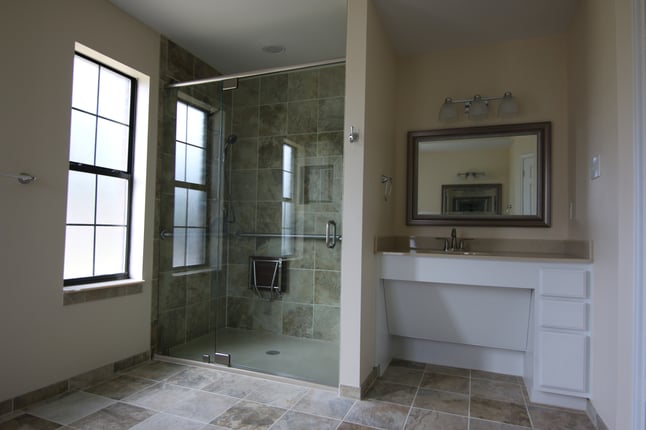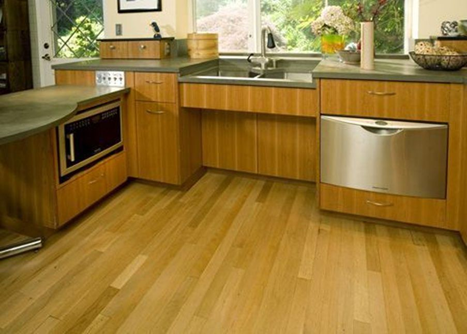Perhaps you haven't personally experienced a problematic living situation concerning your home yet, but you might know someone who has. It could concern a family member, a friend, or just a person in your neighborhood. These unfortunate scenarios are too common in our society, as everyone is living longer due to modern medicine; but this situation is not age-related. Health problems can appear unexpectedly at any age. Our traditional homes commonly lack accessibility for any residents or their visitors who are even slightly challenged. The truth is, all of our houses are built for unchallenged, healthy people of a "normal" size. The moment any diversity to what each of us knows as near perfect health expresses itself, the realization we need a better and more adaptable "mousetrap" comes to mind in regards to our home. The doors in the house aren't wide enough, the rooms are too small, the hallway is too narrow, the floors aren't level or are slippery, the stairs aren't negotiable, the bathroom facilities aren't useable, and the kitchen is not user- friendly. The list goes on-and-on when you are living in a status-quo home. But now people can become educated and know what to ask for before a life-changing problem arises. Rest assured, you have the ability to proactively prepare your traditional home for future life changes before they happen. Hence, there is no need for you or your family to suddenly become trapped inside it's walls! Let's come to understand a design solution exists which has been stigmatized because of it's decades-long association with disability. Learn to ask for it by name.
Universal Design, also known as barrier-free design and design for all, refers to broad-spectrum ideas meant to produce buildings, products and environments that are inherently accessible to non-challenged people, older people, people of any age who are mentally or physically challenged, and people overcoming an illness or physically-altering accident. In general, it represents a universal need in future housing and pertains to adding safety and accessibility in an existing home for all people regardless of their size or physical well being at any time. The purpose of the design is to provide equal access to anyone into and throughout the home. Universal Design adaptations have a broad market appeal to everyone for achieving ease-of-use and convenience accommodating a certain reality. The reality is that all people exist along a continuum of human performance as per their personal traits and characteristics regardless of their age. A universal approach to design takes into account that everyone has varying degrees of ability and disability; rather than someone is either fully-functional or disabled. Universal Design is neither a design style or trend but is an approach to designing home access for as wide a range of diverse people as possible.
As a solution to our inaccessible housing predicament, applying Universal Design is important because current design standards for housing do not address the design needs of more than one-third of our population. Too often, the designers of homes allow the built environment to define the capabilities of the resident, rather than the opposite being true. That has always been the problem evidenced by the current inaccessible housing inventory. People typically purchase a house according to their needs of the day, never considering their future needs. This way of thinking has perpetuated the problem of inaccessibility within traditional homes. Incorporating Universal Design principles into today's houses allows for our antiquated architecture to be redefined by both our changing human needs and abilities. It has the ability to span all generations of inhabitants. The sooner the principles exist in a home, the longer it can be enjoyed by everyone; because no one is excluded. Home accessibility should be a concern no matter what your age. If your concerns are not for you, barring any life changing accident, they could concern the accessibility and safety for another generation's independence. As we become more life-experienced, our society is beginning to realize our homes should be flexible to accommodate future life changes. This benefit alone will afford adapted housing the ability to conform to our needs. Hence, society will understand the significance of a forever home. The physical life changes involved can be long-term or of short duration while recovering from an accident or disease. Regardless, the home is prepared for what comes next through the use of Universal Design.
The recent Aging in Place phenomena deals with reactive home modifications to existing homes due to health changes of one or more residents. The adaptations allow the inhabitants to remain within their home safely as they age. A planned Universal Design home quietly and proactively addresses abrupt issues without calling attention to anyone. The design simply anticipates the homeowner's changing needs. The modifications can be performed room by room overtime or all at once. Furthermore, Universal Design segues seamlessly into what is required for Aging in Place. However, we cannot conceive or solve all future situations for everyone because we all age differently with our own list of specific needs. In extreme cases, a specialized accessibility design comes into play customized around a single person's needs.
But what about the costs involved in a home using Universal Design? Utilizing Universal Design in a new build home isn't necessarily more expensive than a status-quo traditional inaccessible home. It generally approaches a three-to-four-percent overall increase. The same building techniques are involved in both; but the Universal Design home is designed with more forethought and expertise to improve safety, accessibility, and comfort. Consequently, if you are remodeling an existing home, incorporating the principles of Universal Design, it is more costly on the order of fifteen-to-twenty-percent because you not only have the updated building costs to consider but the demolition costs as well. The same remodeling costs for the preparation of a revised layout are involved with any type renovation prior to the modifications beginning, whether the final appearance is traditional or universal in nature.

Basically, Universal Design principles involve the design of products and environments to be usable by all people, to the greatest extent possible, without the need for adaptation or specialized design. Using Universal Design, there are seven design criteria which must be met to be considered a Universal Design no matter which area of the home you are referring to. Any design must be (1) equally useful to everyone, (2) have flexibility in it's usefulness, (3) be simple and intuitive, (4) be perceived by everyone, (5) have a tolerance for error, (6) require little physical effort, and (7) it must maintain an adequate area for approach and use. Any complexity or discriminating attribute to a design will doom it in terms of being considered universal in nature. However, what better way can you improve on a home's total visitability? The term visitability pertains to anyone entering freely into a home, having unrestricted maneuverability throughout the home, and having the ability to enter and utilize a bathroom's facilities without assistance.

Whether you refer to this needed housing revolution today as accessible design, inclusive design, or Universal Design, it is all about making a home safe, attractive, and easy to use for all residents. It has nothing to do with the age, agility, or status of life for anyone living within the home. The main intent of this way of thinking is to be sure the inhabitants and their visitors are equally able to enjoy their home throughout their entire lifetime. This way Aging in Place can be accomplished without the expense and hassle of having to make periodic or interfering abrupt changes to the home to meet a person's ever-changing physical needs. With Universal Design, you have the ability to proactively plan for all stages of your life cycle using forethought which, once discovered, you ultimately find is just common sense. Even if you are in perfect health, you can be disrupted by a minor mishap. A more serious injury changes things forever once you no longer have all your abilities. Universal design ideas do not strictly deal with accessibility or Aging in Place design and does not implement precise ADA standards; but it does offer flexibility to add accessories now and later to those planning ahead or to the end-user. It also provides for a wide range of human performance characteristics for the way people use spaces within their homes including well integrated usability features. Hence, a Universal Design/build project is appealing to all users.
Can you envision building a house as a young adult that you can live in safely and comfortably while you age no matter what your basic physical needs require? In this home, visitors are never problematic if they exhibit limited mobility or other issues. This flexible Universal Design home contains wider doorways of 36-inches or more and adequately lit hallway widths of 42-48-inches to accommodate a stroller, wheelchair or walker. There is a wide-open feeling of comfort throughout the house's main living areas in the bathroom, kitchen, and living area that do not restrict moving about. A five-foot turning radius is observed throughout the home. Wood blocking is installed behind the finished walls in all wet areas to accommodate secure grab bar installations at the proper time. The towel racks in the kitchen are installed so they can double as grab bars once you become unsteady from lack of balance. All the no-step entryways from the front door to the shower entrance are smooth to prevent tripping from high thresholds and all flooring transitions are level. Non-slip flooring is installed, especially in wet areas, using cork or smaller floor tiles which in turn increase friction from the grout lines. All doors and faucets are controlled by lever hardware. Sinks inside the bathroom and kitchen have roll-under capability. Within the sink base cabinets, doors or roll-out shelving are installed until the roll-under design is needed. Full-extension drawers and pull-out shelves are installed in lieu of doors. The cabinet tops and work areas throughout the house are placed at varying heights to promote adaptability. This universal designed home is barrier-free without looking modified and is accessible to everyone no matter their age, size, or capability of movement. Furthermore, this home is usable by everyone from your father to your son.
David L. Traut, CAPS the owner of T-Square Company in Austin, Texas is one of the select group of professionals to earn the Certified Aging In Place Specialist (CAPS) designation, identifying him as a home remodeler and builder with the skills and knowledge necessary to remodel or modify a home to meet the unique needs of the older population, disabled owners, or their visitors. Consequently, David is certified in Universal Design in the US and Australia. T-Square Company is a Universal Design contractor offering a full compliment of Aging in Place services including bathroom modifications for elderly clients with special needs. Each design/build project contains the principles of Universal Design. The modifications will be customized to fit your personal needs while increasing your accessibility. Call 512-444-0097 today to begin the accessible second chapter of your life while remaining safe and secure in your existing home. CAPS #1636580
As an answer to his clients requests over the years, David has recently published a book entitled "Age in Place at Home: Adapting the Home Environment for All Generations". The book reflects on thirty years of accessibility improvements and identifies why our traditional homes specifically lack this very basic need. It is available on Amazon and stands as a reference book for increasing home accessibility using the principles of Universal Design in every room of the home. The book dwells on this inclusive design concept as a solution to our current housing dilemma.


















